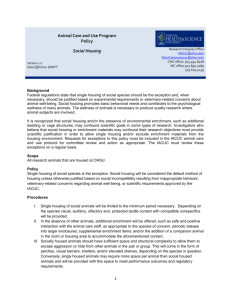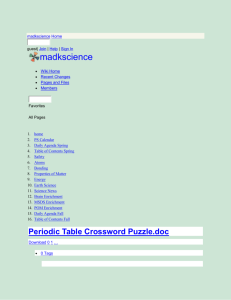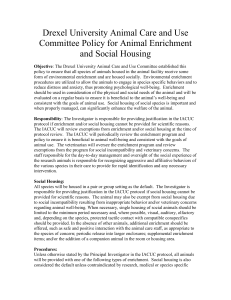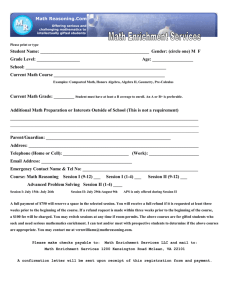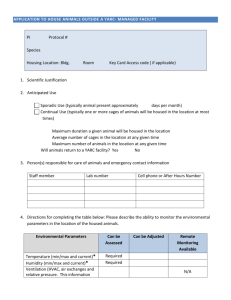Policy on Housing and Environmental Enrichment for Laboratory Animals UCSD INSTITUTIONAL
advertisement
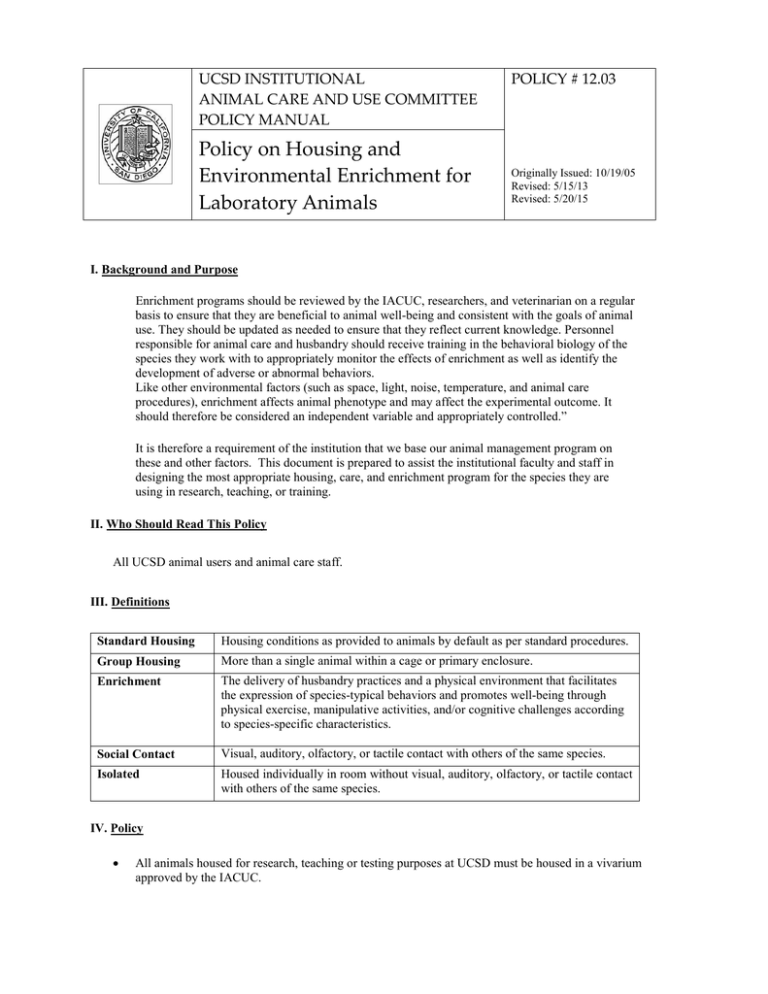
UCSD INSTITUTIONAL ANIMAL CARE AND USE COMMITTEE POLICY MANUAL Policy on Housing and Environmental Enrichment for Laboratory Animals POLICY # 12.03 Originally Issued: 10/19/05 Revised: 5/15/13 Revised: 5/20/15 I. Background and Purpose Enrichment programs should be reviewed by the IACUC, researchers, and veterinarian on a regular basis to ensure that they are beneficial to animal well-being and consistent with the goals of animal use. They should be updated as needed to ensure that they reflect current knowledge. Personnel responsible for animal care and husbandry should receive training in the behavioral biology of the species they work with to appropriately monitor the effects of enrichment as well as identify the development of adverse or abnormal behaviors. Like other environmental factors (such as space, light, noise, temperature, and animal care procedures), enrichment affects animal phenotype and may affect the experimental outcome. It should therefore be considered an independent variable and appropriately controlled.” It is therefore a requirement of the institution that we base our animal management program on these and other factors. This document is prepared to assist the institutional faculty and staff in designing the most appropriate housing, care, and enrichment program for the species they are using in research, teaching, or training. II. Who Should Read This Policy All UCSD animal users and animal care staff. III. Definitions Standard Housing Housing conditions as provided to animals by default as per standard procedures. Group Housing More than a single animal within a cage or primary enclosure. Enrichment The delivery of husbandry practices and a physical environment that facilitates the expression of species-typical behaviors and promotes well-being through physical exercise, manipulative activities, and/or cognitive challenges according to species-specific characteristics. Social Contact Visual, auditory, olfactory, or tactile contact with others of the same species. Isolated Housed individually in room without visual, auditory, olfactory, or tactile contact with others of the same species. IV. Policy • All animals housed for research, teaching or testing purposes at UCSD must be housed in a vivarium approved by the IACUC. Housing and Environmental Enrichment for Laboratory Animals Date: 05.20.15 Page 2 of 5 • • • • • • • Each animal housing room maintains a single species at any given time unless special housing arrangements have been made for compatible species. Enrichment and appropriate social contact must be provided according to the table below. Changes from the standards listed below are not allowed except under the following two circumstances: o Changes are described in the applicable animal use protocol approved by the UCSD IACUC. o The UCSD Animal Care Program Veterinary Health Unit prescribes the change. Provision of enrichment must be provided so as not to cause undue stress or otherwise harm the animal or alter the species appropriate standards for husbandry, nutritional requirements or housing. Physical materials used for enrichment must be easily sanitizable to the level of the building SOPs. ACP husbandry will provide enrichment to any singly housed mouse, rat, hamster, guinea pig or other rodent. PIs must anticipate this and provide alternative approved enrichment or label cage with special instruction to NOT provide (this must be justified and approved in protocol). Materials and labor costs associated with optional enrichment will be the responsibility of the principal investigator. UCSD Standard Housing/Enrichment Requirements Species Standard Housing and Enrichment for Group Housed Animals Enrichment for Singly Housed Animals Optional Enrichment Requirements for group housed animals. Changes from these standards are not allowed except by IACUC or ACP Veterinary approval. Requirements for singly housed animals. Changes from these standards are not allowed except by IACUC or ACP Veterinary approval. These options are not required to be addressed in the IACUC Protocol. PI must decide which animals receive and arrange for the provision of this enrichment. Mice Rats Hamsters Guinea Pigs Other Rodents Group housed whenever possible. ACP approved polystyrene, polycarbonate, or other high temp solid bottom plastic cage fitted with a functioning filter-top or polyethylene disposable cages. Cages may be connected to racks providing filtered air. Commercially available paper, wood chip or Corn Cob type bedding. Wire bar lid, frame or box feeder. Resting lofts where applicable (i.e. Techniplast caging). Water bottle or lixit for automatic watering. ACP approved feed in a feed hopper or wire bar lid. Singly housed animals will be provided with one of the following: Provision of cotton nesting material, sterilized paper, paper or plastic enclosures. Rabbits Individually housed, but with social contact with conspecifics whenever possible. Easily sanitizable wire bottom caging of appropriate size for the species. Water bottle or lixit for automatic watering at all times. Nutritionally complete pelleted food per weight daily. Enrichment materials that are sanitizable, (hard balls, plastic chains, PVC pieces, nylabones) will be placed in cages. Small portions of timothy hay or other grass hay, in portions that will not offset normal diet. Single isolated animals will have positive human interaction daily. • • • • • cotton nesting material sterilized paper towel paper towel (not sterile) paper or plastic tubes bedding enriched w/ paper nesting chips Small portions of fruit, vegetables, alfalfa not to interfere with primary diet. Housing and Environmental Enrichment for Laboratory Animals Date: 05.20.15 Page 3 of 5 Ruminants Group house or social contact with conspecifics whenever possible. Sheltered outdoor coral – secure chain link or pipe fencing, or indoor area supplied with dry straw for resting. Water source available at all times, nutritionally complete pelleted feed per weight daily plus alfalfa hay supplement. Single isolated animals will have positive human interaction daily. Sweet feed or salt block. Not to interfere with primary diet. Swine Individually housed, but with social contact with conspecifics whenever possible. Indoor or sheltered outdoor housing of appropriate size based on weight. Water source available at all times, nutritionally complete pelleted feed per weight daily. Enrichment materials that are sanitizable, (hard balls, plastic chains, PVC pieces, nylabones) will be placed in cages. Single isolated animals will have positive human interaction daily. Small portions of vegetables or fruit or other commercially available food, not to interfere with primary diet. Cats Group house or social contact with conspecifics whenever possible. Indoor caging of appropriate size, with litter box cleaned daily. Water source available at all times, nutritionally complete feed per weight daily. Toys - balls, hanging toys or other appropriate toys at all times. All cats will have positive human interaction daily. Single isolated animals will have positive human interaction daily. Commercially available cat treats, not to interfere with primary diet. Dogs Group house or social contact with conspecifics whenever possible. Indoor or outdoor runs with area sized as appropriate for the number of occupants. Bedding or bunk, clean and dry. Run cleaned daily. Water source available at all times, nutritionally complete canine feed per weight daily. Enrichment materials that are sanitizable, (balls, nylabones) or compressed rawhide, hooves, thread ropes, and other objects. Positive human interaction daily. Exercise where animals are allowed out of primary cages to explore/ interact with conspecifics at least 3x/week. All dogs will have positive human interaction daily. Single isolated animals will have positive human interaction daily. Commercially available canine treats not to interfere with primary diet. Non-Human Primates Group house or social contact with conspecifics whenever possible. Indoor primate caging with perch, and play features optimized for the species. Clean cage daily. Water source available at all times. Fed commercial primate food daily as determined to maintain weight. Food treats, novel food items such as fruit, nuts, or vegetables provided as rewards for positive human interaction, behavioral modification, or as forage or browse. Safe cage furniture consistent Singly isolated animals will have positive human interaction daily. Food treats not to interfere with primary diet. Novel toys or other devices, such as radio or television in a volume and manner not to interfere with the animal’s normal behavior. Housing and Environmental Enrichment for Laboratory Animals Date: 05.20.15 Page 4 of 5 with the species, and easily sanitizable. Enrichment materials that are sanitizable, (balls, nylabones) or compressed rawhide, hooves, thread ropes, and other objects. All primates, will have positive human interaction daily. Reptiles/ Other Amphibian Group housed whenever possible in easily sanitizable and secured enclosures with a safe heating device located in such a way to allow animal to thermoregulate appropriately for the species. Substrate that is easily sanitizable and appropriate for the species. Fresh water (dechlorinated for amphibian species) and nutritionally complete feed appropriate for the species. Hiding tubes boxes and perches of appropriate size. Same as for group housed reptiles/other amphibians. Xenopus Group housed in water tanks or tubs with PVC pipe or a floating device that is removable and sanitizable. Dechlorinated water, temp appropriate for species flushed daily post feeding, and free of significant debris. Nutritionally complete commercially available food, appropriate for the species. Same as for group housed xenopus. Fish Group housed in water tanks. Dechlorinated water, temp appropriate for species continuous recirculation of water to maintain free of significant debris. Nutritionally complete commercially available food, appropriate for the species. Same as for group housed fish. Birds Group housed whenever possible in smooth wire cages adequate for the species. Flight cages if possible or alternate enrichment made available. Perches adequate to prevent foot disease, water source available at all times, food nutritionally complete for the species, and access to materials for maintaining crop. Same as for group housed birds. Food items and treats not to constitute a substantial portion of the standard diet. V. Related Documents The Guide to the Care and Use of Laboratory Animals UCSD Cage Size Reference http://grants1.nih.gov/grants/olaw/Guide-for-theCare-and-Use-of-Laboratory-Animals.pdf http://iacuc.ucsd.edu/policies/CageSizes.pdf Housing and Environmental Enrichment for Laboratory Animals Date: 05.20.15 Page 5 of 5 VI. Additional information • Enrichment must be conducted in such a way to not interfere with the research results, or must be controlled appropriately.
